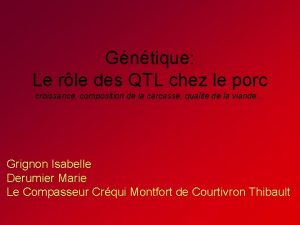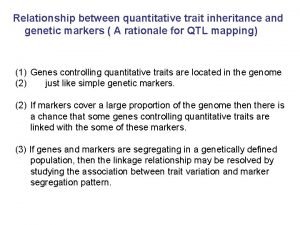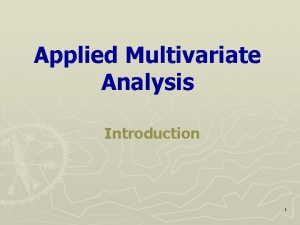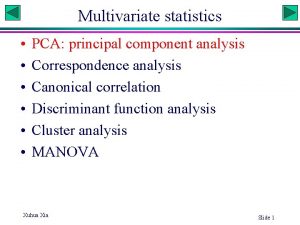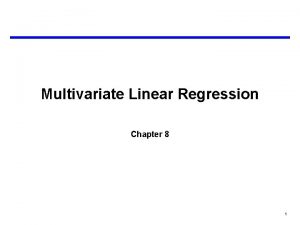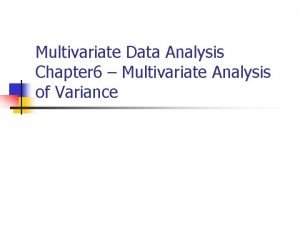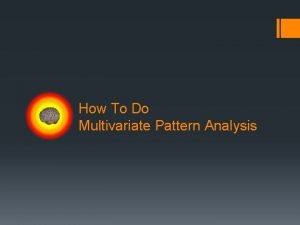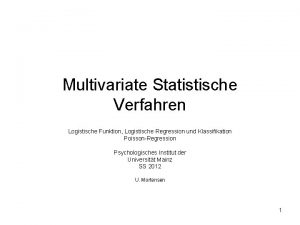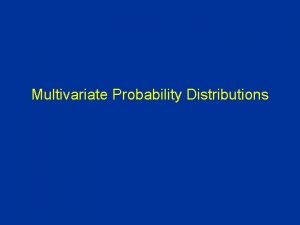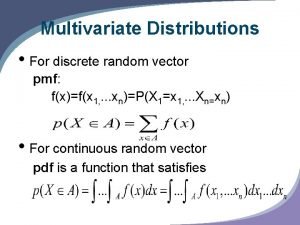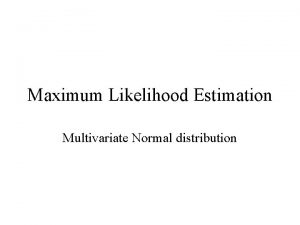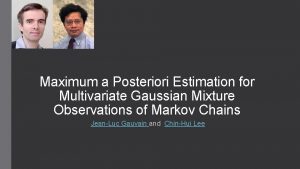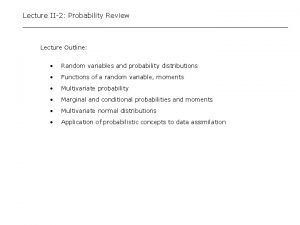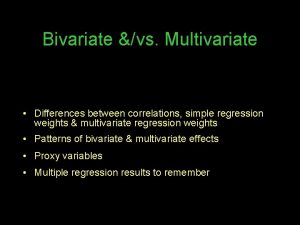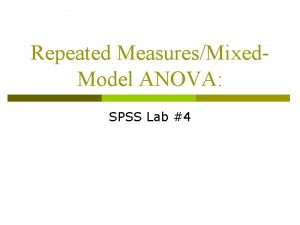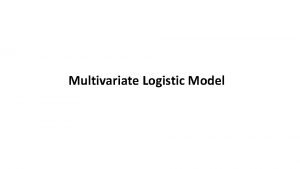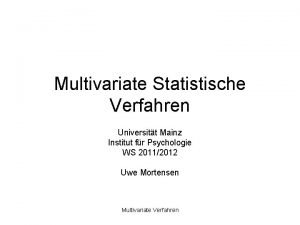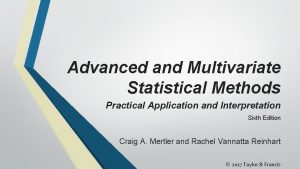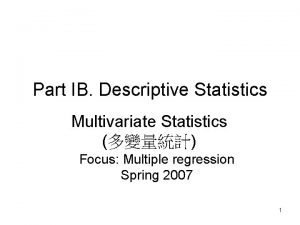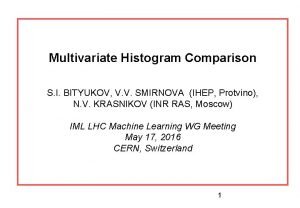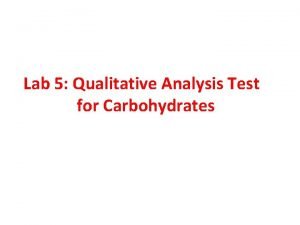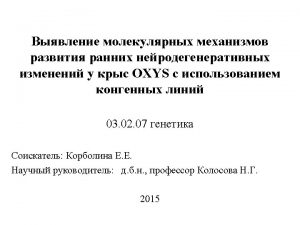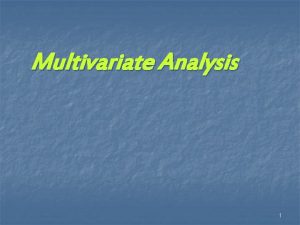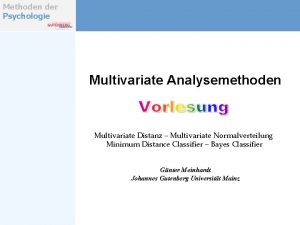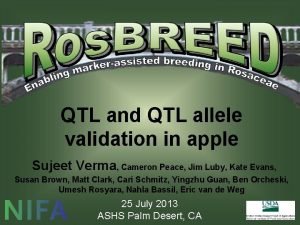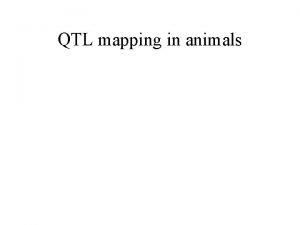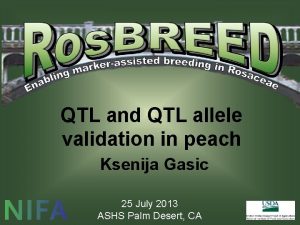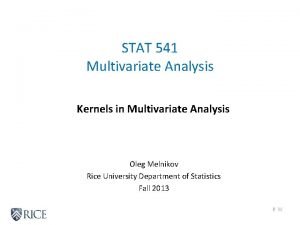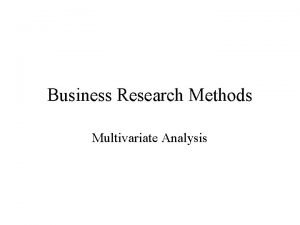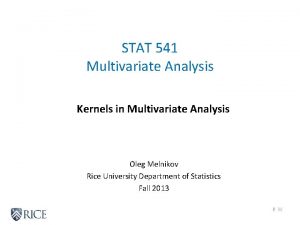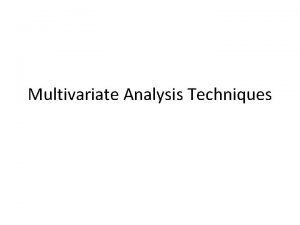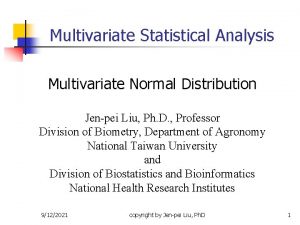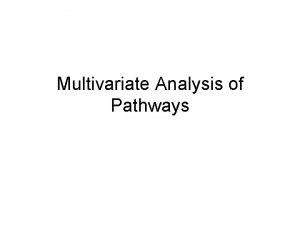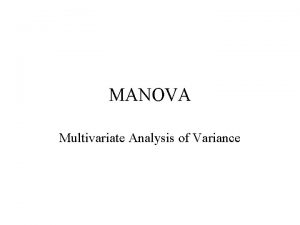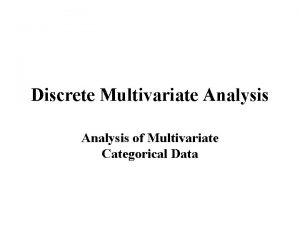Introduction to multivariate QTL Theory Practical Genetic analysis















































- Slides: 47

Introduction to multivariate QTL • Theory • Practical: Genetic analysis of Blood Pressure data (4 observations across a 20 year period) • QTL analysis of multivariate data • Practical: QTL analysis BP data Dorret Boomsma, Meike Bartels, Danielle Posthuma & Sarah Medland

Multivariate models • Principal component analysis (Cholesky) • Exploratory factor analysis (Spss) • Confirmatory factor analysis (Lisrel) • Path analysis (S Wright) • Structural equation models These techniques are used to analyze multivariate data that have been collected in non-experimental designs and often involve latent constructs that are not directly observed. These latent constructs underlie the observed variables and account for correlations between variables.

The covariance between x 1 and x 4 is: cov (x 1, x 4) = 1 4 = cov ( 1 f + e 1, 4 f + e 4 ) where is the variance of f and e 1 and e 4 are uncorrelated f 1 2 3 4 x 1 x 2 x 3 x 4 e 1 e 2 e 3 e 4 Sometimes x = f + e is referred to as the measurement model. The part of the model that specifies relations among latent factors is the covariance structure model, or the structural equation model

Symbols used in path analysis square box: observed variable (x) circle: latent (unobserved) variable (f) unenclosed variable: disturbance term (error) in equation ( ) or measurement (e) straight arrow: causal relation ( ) curved two-headed arrow: association (r) two straight arrows: feedback loop

Tracing rules of path analysis The associations between variables in a path diagram is derived by tracing all connecting paths between variables: 1 trace backward along an arrow, then forward • never forward and then back; • never through adjacent arrow heads 2 pass through each variable only once 3 trace through at most one two-way arrow The expected correlation/covariance between two variables is the product of all coefficients in a chain and summing over all possible chains (assuming no feedback loops)

Genetic Structural Equation Models Confirmatory factor model: x = f + e, where x = observed variables f = (unobserved) factor scores e = unique factor / error = matrix of factor loadings "Univariate" genetic factor model Pj = h. Gj + e Ej + c Cj , j = 1, . . . , n (subjects) where P = measured phenotype G = unmeasured genotypic value C = unmeasured environment common to family members E = unmeasured unique environment = h, c, e (factor loadings/path coefficients)

Univariate ACE Model for a Twin Pair 1 1/. 5 E C e c P A A a a C c P E e r. A 1 A 2 = 1 for MZ r. A 1 A 2 = 0. 5 for DZ Covariance (P 1, P 2) = a r. A 1 A 2 a + c 2 r. MZ = a 2 + c 2 r. DZ = 0. 5 a 2 + c 2 2(r. MZ-r. DZ) = a 2

A 1 a 11 1/. 5 A 2 A 1 a 21 P 11 e 11 a 11 P 21 e 21 E 1 a 22 A 2 a 21 P 12 e 22 E 2 e 11 a 22 P 22 e 21 E 2 Bivariate twin model: The first (latent) additive genetic factor influences P 1 and P 2; The second additive genetic factor influences P 2 only. A 1 in twin 1 and A 1 twin 2 are correlated; A 2 in twin 1 and A 2 in twin 2 are correlated (A 1 and A 2 are uncorrelated)

Identification in Genetics Identification of a genetic model is obtained by using data from genetically related individuals, such as twins, or parents and offspring, and by knowledge about the constraints for certain parameters in the model, whose values are based on Mendelian inheritance. Quantitative genetic theory offers a strong foundation for the application of these models in genetic epidemiology because unambiguous causal relationships can be specified. For example, genes 'cause' a variable like blood pressure and parental genes determine those of children and not vice versa

Bivariate Phenotypes r. G AC AX AY h. C h. X X 1 h. Y Y 1 Correlation A SY A SX A 2 h. C h. SX X 1 A 1 h. SY Y 1 Common factor h 1 X 1 h 2 h 3 Y 1 Cholesky decomposition

Correlated factors r. G AX h. X X 1 • Genetic correlation r. G AY h. Y Y 1 • Component of phenotypic covariance r. XY = h. Xr. Gh. Y + c. Xr. Cc. Y + e. Xr. Ee. Y

Common factor model AC A SY A SX h. C h. SX X 1 h. SY Y 1 A constraint on the factor loadings is needed to make this model identified

Cholesky decomposition A 1 h 1 X 1 A 2 h 3 Y 1 - If h 3 = 0: no genetic influences specific to Y - If h 2 = 0: no genetic covariance - The genetic correlation between X and Y = covariance / SD(X)*SD(Y)

A 1 a 11 1/. 5 A 2 A 1 a 21 P 11 e 11 a 11 P 21 e 21 E 1 a 22 A 2 a 21 P 12 e 22 E 2 e 11 a 22 P 22 e 21 E 2 Bivariate twin model: The first (latent) additive genetic factor influences P 1 and P 2; The second additive genetic factor influences P 2 only. A 1 in twin 1 and A 1 twin 2 are correlated; A 2 in twin 1 and A 2 in twin 2 are correlated (A 1 and A 2 are uncorrelated)

Implied covariance structure • See handout

Four variables: blood pressure F 1 F 2 F 3 F 4 F: Is there familial (G or C) transmission? P 1 E 1 P 2 E 2 P 3 E 3 P 4 E: Is there transmission of non-familial influences?

Genome-wide scans for blood pressure in Dutch twins and sibs Phenotypes: Dorret Boomsma Harold Snieder Danielle Posthuma Mireille van den Berg /Nina Kupper Eco de Geus Jouke Jan Hottenga Genotypes Eline Slagboom Marian Beekman Bas Heijmans Jim Weber (study 1; 2; 3; 4; 1985) 1990) 1998) 2002) Vrije Universiteit, Amsterdam Molecular Epidemiology, Leiden Marshfield, USA

Design and N of individuals 56 138 203 N=320 N=424 N=751 N=566 126 14 N of Ss who participated in 3 studies: 53, in 2 studies: 378 and in 1 study: 1146 (only offspring; 1 Ss from triplets and families with size > 6 removed) BP levels corrected for medication use

Study 1 (Dorret): 320 adolescent twins (& parents) Blood pressure* • Systolic • Diastolic • MAP • Heart rate • Inter-beat interval • Variability • RSA • Pre-ejection period • Height / Weight • Birth size • Non-cholest. Sterols • Lipids • CRP • Fibrinogen • HRG * Assessed in rest and during stress; resting BP averaged over 6 measures Boomsma, Snieder, de Geus, van Doornen. Heritability of blood pressure increases during mental stress. Twin Res. 1998

Study 2 (Harold): 424 adult twins Same as study 1 plus • Waist & hip circumference, • Skin folds • %fat • PAI, • t. PA, • v. Willebrand • Glucose • Insuline • Hematocrit BP assessed in rest and during stress; resting BP averaged over 3 measures Snieder, Doornen van, Boomsma, Developmental genetic trends in blood pressure levels and blood pressure reactivity to stress, in: Behavior Genetic Approaches in Behavioral Medicine, Plenum Press, New York, 1995

Study 3 (Danielle): 751 adult twins and sibs • • • Cognition Memory Executive function EEG/ ERP MRI blood pressure BP assessed in rest; averaged over 3 measures Evans et al. The genetics of coronary heart disease: the contribution of twin studies. Twin Res. 2003

Study 4 (Nina): 566 adult twins and sibs Ambulatory measures • ECG • ICG • RR • cortisol • blood pressure Average of at least 3 ambulatory BP measures while sitting (during evening) Kupper, Willemsen, Riese, Posthuma, Boomsma, de Geus. Heritability of daytime ambulatory blood pressure in an extended twin design. Hypertension 2005

Sex MZ M F DZ M F Sib M F Variable N age SBP DBP N age SBP DBP Dorret Study 1 70 16. 6 (1. 8) 119. 8 (8. 2) 65. 6 (6. 4) 70 16. 0 (2. 2) 115. 0 (5. 7) 67. 6 (4. 7) 91 16. 9 (1. 8) 119. 8 (9. 3) 65. 6 (7. 4) 89 17. 2 (1. 9) 115. 3 (7. 3) 67. 9 (5. 6) - Harold Study 2 92 42. 9 (5. 6) 129. 1 (11. 9) 80. 5 (9. 6) 98 45. 4 (7. 4) 120. 7 (12. 0) 73. 5 (10. 0) 114 44. 6 (7. 1) 127. 6 (11. 7) 78. 2 (8. 9) 120 44. 1 (6. 3) 124. 5 (16. 2) 75. 7 (11. 8) - Danielle Study 3 117 36. 8 (12. 3) 129. 7 (14. 4) 77. 6 (12. 6) 147 39. 0 (13. 1) 122. 5 (14. 4) 74. 8 (10. 0) 125 36. 2 (13. 1) 129. 6 (12. 4) 77. 6 (11. 8) 175 37. 0 (12. 7) 124. 6 (16. 2) 76. 1 (11. 0) 88 37. 3 (14. 2) 128. 3 (13. 0) 78. 3 (11. 2) 99 37. 3 (12. 8) 124. 3 (16. 4) 76. 4 (10. 2) Nina Study 4 57 34. 0 (13. 1) 129. 7 (11. 1) 77. 5 (9. 6) 108 29. 0 (10. 5) 124. 0 (10. 8) 77. 1 (9. 2) 80 29. 3 (8. 8) 131. 1 (10. 7) 77. 6 (8. 9) 137 30. 9 (11. 3) 125. 4 (12. 9) 78. 0 (10. 9) 74 35. 2 (13. 1) 130. 4 (9. 7) 79. 2 (8. 4) 110 36. 7 (11. 9) 122. 6 (12. 2) 77. 0 (9. 7) Data corrected for medication use (by adding means effect of van anti-hypertensiva)

Stability (correlations SBP / DBP) between measures in 1983, 1990, 1998 and 2003. 57 /. 62. 60 /. 59 . 62 /. 67 1983 1990 1998 . 51 /. 47. 44 /. 58 Does heritability change over time? Is heritability different for ambulatory measures? What is the cause of stability over time? 2003

Assignment • ACE Cholesky decomposition on SBP (and / or DBP) on all data (4 time points) • Test for significance of A and C • What are the familial correlations across time (i. e. among A and / or C factors) • Can the lower matrix for A, C, E be reduced to a simpler structure?

Four blood pressure measurements A 1 BP 1 E 1 A 2 A 3 A 4 BP 2 BP 3 BP 4 E 2 E 3 E 4 Can A be reduced to 1 factor? E: Is there transmission over time (is E a diagonal matrix? )

A BP 1 BP 2 Can the model for A (additive genetic influences) be reduced to 1 factor? BP 3 BP 4

#DEFINE NVAR 4 #DEFINE NDEF 2 ! NUMBER OF DEFINITION VARIABLES #NGROUPS 3 ! NUMBER OF GROUPS G 1: CALCULATION GROUP DATA CALCULATION BEGIN MATRICES X LOWER NVAR FREE Y LOWER NVAR FREE Z LOWER NVAR FREE H FULL 1 1 FIX G FULL 1 8 FREE R FULL NDEF 1 FREE S FULL NDEF 1 FREE T FULL NDEF 1 FREE U FULL NDEF 1 FREE END MATRICES ! ADDTIVE GENETIC ! COMMON ENVIRONMENT ! UNIQUE ENVIRONMENT ! HALF-MATRIX (contains 0. 5) ! GENERAL MEANS SAMPLES ! DORRET REGRESSION COEFFICIENTS COVARIATES ! HAROLD REGRESSION COEFFICIENTS COVARIATES ! DANIELLE REGRESSION COEFFICIENTS ! NINA REGRESSION COEFFICIENTS C

G 2: MZM DATA NINPUT_VARS=45 MISSING=-99. 0000 RECTANGULAR FILE = C 11 P 50. PRN LABELS ID 1 ID 2 PAIRTP TWZYG DOSEX 1 DOAGE 1 DOMDBP 1 DOMSBP 1 DOMED 1 HASEX 1 HAAGE 1 HAMDBP 1 HAMSBP 1 HAMED 1 DASEX 1 DAAGE 1 DAMDBP 1 DAMSBP 1 DAMED 1 NISEX 1 NIAGE 1 NIMDBP 1 NIMSBP 1 NIMED 1 DOSEX 2 DOAGE 2 DOMDBP 2 DOMSBP 2 DOMED 2 HASEX 2 HAAGE 2 HAMDBP 2 HAMSBP 2 HAMED 2 DASEX 2 DAAGE 2 DAMDBP 2 DAMSBP 2 DAMED 2 NISEX 2 NIAGE 2 NIMDBP 2 NIMSBP 2 NIMED 2 PIHAT !data for twin 1 and twin 2 SELECT IF TWZYG < 4; !MZ Selected SELECT IF TWZYG ^= 2; SELECT DOSEX 1 DOAGE 1 HASEX 1 HAAGE 1 DASEX 1 DAAGE 1 NISEX 1 NIAGE 1 DOMSBP 1 HAMSBP 1 DAMSBP 1 NIMSBP 1 DOSEX 2 DOAGE 2 HASEX 2 HAAGE 2 DASEX 2 DAAGE 2 NISEX 2 NIAGE 2 DOMSBP 2 HAMSBP 2 DAMSBP 2 NIMSBP 2; DEFINITION DOSEX 1 DOAGE 1 DOSEX 2 DOAGE 2 HASEX 1 HAAGE 1 HASEX 2 HAAGE 2 DASEX 1 DAAGE 1 DASEX 2 DAAGE 2 NISEX 1 NIAGE 1 NISEX 2 NIAGE 2;

Data and scripts • F: meikeBP 2005phenotypic • ACEBP Elower. mx: 4 variate script for genetic analysis (Cholesky decomposition) • Input file = C 11 P 50. prn • ACE Cholesky decomposition on SBP (and / or DBP) on all data (4 time points) • Test for significance of A and C • What are the familial correlations across time (i. e. among A and / or C factors) • Can the lower matrix for A, C, E be reduced to a simpler structure?

Stability (correlations SBP / DBP) between measures in 1983, 1990, 1998 and 2003. 57 /. 62. 60 /. 59 . 62 /. 67 1983 1990 1998 . 51 /. 47. 44 /. 58 Does heritability change over time? Is heritability different for ambulatory measures? What is the cause of stability over time? 2003

Full Cholesky: standardized matrices MATRIX K This is a computed FULL matrix of order [=STND(A)] 1 2 3 4 1 1. 0000 0. 8813 0. 9653 0. 9975 2 0. 8813 1. 0000 0. 8873 0. 8890 3 0. 9653 0. 8873 1. 0000 0. 9814 4 0. 9975 0. 8890 0. 9814 1. 0000 4 by MATRIX L This is a computed FULL matrix of order 4 by [=STND(C)] 1 2 3 4 1 1. 0000 -0. 9999 1. 0000 2 1. 0000 -0. 9999 1. 0000 3 -0. 9999 1. 0000 -1. 0000 4 1. 0000 -1. 0000 MATRIX M This is a computed FULL matrix of order 4 by [=STND(E)] 1 2 3 4 1 1. 0000 -0. 0732 0. 1795 0. 3984 2 -0. 0732 1. 0000 0. 1898 -0. 0273 3 0. 1795 0. 1898 1. 0000 0. 1498 4 0. 3984 -0. 0273 0. 1498 1. 0000 4 Heritability = 51, 41, 57, 43% 4 Common E = 06, 00, 01% 4 Unique E = 42, 58, 43, 55%

Results total sample (systolic BP) • • -2 log-likelihood of data ACE Cholesky, 42 parameters, 16261. 760 E diagonal, 36 parameters, 16268. 885 A factor, no C, E Cholesky, 26 parameters, 16263. 931 A factor, no C, E diagonal, 20 parameters, 16270. 30

A BP 1 e 1 BP 2 e 2 The model for A (additive genetic influences) can be reduced to 1 factor. BP 3 e 3 BP 4 e 4 E is both unique to an individual and to an occasion.

Reduced model – sex and age regression MATRIX R This is a FULL matrix of order 1 1 -3. 7860 2 0. 7127 MATRIX S This is a FULL matrix of order 1 1 -7. 2228 2 0. 2610 MATRIX T This is a FULL matrix of order 1 1 -6. 3103 2 0. 5559 MATRIX U This is a FULL matrix of order 1 1 -5. 9046 2 0. 2267 MATRIX G 2 by 1 SPECIFY B DOSEX 1 DOAGE 1; SPECIFY D HASEX 1 HAAGE 1; SPECIFY F DASEX 1 DAAGE 1; 2 by 1 SPECIFY K NISEX 1 NIAGE 1; SPECIFY L DOSEX 2 DOAGE 2; SPECIFY M HASEX 2 HAAGE 2; SPECIFY N DASEX 2 DAAGE 2; 2 by 1 SPECIFY O NISEX 2 NIAGE 2; BEGIN ALGEBRA; J = B*R | D*S | F*T | K*U | L*R | M*S | N*T | O*U; END ALGEBRA; 2 by 1 This is a FULL matrix of order 1 2 3 MEANS G+J; 1 by 4 8 5 6 7 8 110. 6834 124. 7202 116. 1748 128. 0688

Multivariate QTL effects Martin N, Boomsma DI, Machin G, A twin-pronged attack on complex traits, Nature Genet, 17, 387 -391, 1997 See: www. tweelingenregister. org

Multivariate phenotypes & multiple QTL effects For the QTL effect, multiple orthogonal factors can be defined (triangular matrix). By permitting the maximum number of factors that can be resolved by the data, it is theoretically possible to detect effects of multiple QTLs that are linked to a marker (Vogler et al. Genet Epid 1997) For example: on chromosome 19: apolipoprotein E, C 1, C 4 and C 2

Multivariate phenotypes & QTL analysis Multivariate QTL analysis • Insight into etiology of genetic associations (pathways) • Practical considerations (e. g. longitudinal data) • Increase in statistical power: Boomsma DI, Using multivariate genetic modeling to detect pleiotropic quantitative trait loci, Behav Genet, 26, 161 -166, 1996 Boomsma DI, Dolan CV, A comparison of power to detect a QTL in sib-pair data using multivariate phenotypes, mean phenotypes, and factor-scores, Behav Genet, 28, 329 -340, 1998 Evans DM. The power of multivariate quantitative-trait loci linkage analysis is influenced by the correlation between variables. Am J Hum Genet. 2002, 1599 -602 Marlow et al. Use of multivariate linkage analysis for dissection of a complex cognitive trait. Am J Hum Genet. 2003, 561 -70


Genome-wide scan in DZ twins and sibs • 688 short tandem repeats (autosomal) combined from two scans of 370 and 400 markers for ~1100 individuals (including 296 parents; ~100 Ss participated in both scans) • Average spacing ~8. 8 c. M (9. 7 Marshfield, 7. 8 Leiden) • Average genotyping success rate ~85%

Genome-wide scan in DZ twins and sibs • Marker-data: calculate proportion alleles shared identical-by-decent (π) • π = π1/2 + π2 • IBD estimates obtained from Merlin • Decode genetic map Quality controls: • MZ twins tested • Check relationships (GRR) • Mendel checks (Pedstats / Unknown) • Unlikely double recombinants (Merlin)

SBP

A BP 1 e BP 2 e For MZ twins: r (A 1, A 2) = 1 r (Q 1, Q 2) = 1 Q BP 3 e BP 4 e For DZ twins and sibs: r (A 1, A 2) = 0. 5 r (Q 1, Q 2) = “pihat”

Assignment chromosome 11 genome scan Marker data: 2 c. M spacing Phenotypes in MZ twins and genotyped sib/DZ pairs Model: A factor (4 x 1) Q factor (4 x 1) E diagonal (4 x 4) Script: F: meikeBP 2005linkage reduced model. mx Change script and add QTL (e. g. if C is not needed in the model change the ACE model into AQE) Data: F: meikeBP 2005Data files chromosoom 11 C 11 Pxx. prn (a different file for every position)

Alpha 1 -antitrypsin: genotypes at the protease inhibitor (Pi) locus and blood pressure: Dutch parents of twins (solid lines: 130/116 MM males/females, dashed lines 16/22 MZ/MS males/females). Non-MM genotypes have lower BP and lower BP response.


Alpha 1 -antitrypsin: genotypes at the protease inhibitor (Pi) locus and blood pressure: Australian twins (solid lines: 130/127 MM males/females, dashed lines 23/35 MZ/MS males/females). Non-MM males have lower BP.
 Qtl club c'est quoi
Qtl club c'est quoi Genetic markers
Genetic markers Qtl mapping
Qtl mapping Qtl moodle
Qtl moodle Evolutionary drift
Evolutionary drift Genetic programming vs genetic algorithm
Genetic programming vs genetic algorithm Genetic programming vs genetic algorithm
Genetic programming vs genetic algorithm A gene pool consists of
A gene pool consists of Genetic drift vs genetic flow
Genetic drift vs genetic flow Human genetics concepts and applications 10th edition
Human genetics concepts and applications 10th edition What is multivariate
What is multivariate Manova definition
Manova definition Nature of multivariate analysis
Nature of multivariate analysis Multivariate analysis of variance and covariance
Multivariate analysis of variance and covariance Multivariate analysis
Multivariate analysis Multivariate statistical analysis
Multivariate statistical analysis Multivariate analysis
Multivariate analysis Multivariate analysis
Multivariate analysis Multivariate pattern analysis
Multivariate pattern analysis Logistische funktion ableitung
Logistische funktion ableitung Multivariate binomial distribution
Multivariate binomial distribution Multivariate pdf
Multivariate pdf Linear regression spss
Linear regression spss Q1qp
Q1qp Maximum a posteriori estimation for multivariate gaussian
Maximum a posteriori estimation for multivariate gaussian Multivariate pdf
Multivariate pdf Multivariate vs bivariate
Multivariate vs bivariate Mixed design anova spss
Mixed design anova spss Normal equation logistic regression
Normal equation logistic regression Multivariate methods in machine learning
Multivariate methods in machine learning Multivariate verfahren psychologie
Multivariate verfahren psychologie Univariate vs multivariate
Univariate vs multivariate A and b is
A and b is Advanced and multivariate statistical methods
Advanced and multivariate statistical methods Multivariate descriptive statistics
Multivariate descriptive statistics Multivariate statistics for the environmental sciences
Multivariate statistics for the environmental sciences Multivariate histogram
Multivariate histogram The major premise of the biochemical theory is that
The major premise of the biochemical theory is that Kinicki management a practical introduction
Kinicki management a practical introduction Read management: a practical introduction online
Read management: a practical introduction online Practical research
Practical research Management: a practical introduction
Management: a practical introduction Management a practical introduction 3e
Management a practical introduction 3e Management a practical introduction
Management a practical introduction Kurt lewin nothing as practical as a good theory
Kurt lewin nothing as practical as a good theory Practical meta-analysis
Practical meta-analysis Microsoft threat modeling tool
Microsoft threat modeling tool Fructose is non reducing sugar
Fructose is non reducing sugar
